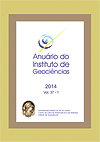Metal Hydrogeochemistry in Stream Water: Granitic and Gnaissic Sources - Paquequer Watershed, Teresópolis, Rio de Janeiro State
DOI:
https://doi.org/10.11137/2014_2_39_47Keywords:
Hydrogeochemistry, Weathering, Geochemistry, Chemical elements.Abstract
The Paquequer watershed (269 km ²) belongs to Paraíba do Sul river drainage basin and is located in the municipal area of Teresopolis, Rio de Janeiro state. Its geology is typical of southeastern Brazil granites and gneisses. The aim of this work was to evaluate the weathering process of these rocks and the mobilities of the chemical elements through a hydrogeochemical approach. 15 river points were sampled. River discharge and physico-chemical parameters were measured. Nine points were located in the main channel and six in the major tributaries. The samples were analyzed by ICP-MS for Si, Fe, Mn, Al, Cu, Ni, Cr, Zn, Ba, Rb, Sr, Pb, Cd and Co and by ion chromatography for Na+, K+, Mg2 + and Ca2 +. Literature data concerning the geochemistry of these rocks was used. The fluvial hydrogeochemistry is dominated by Na, Ca and Si. In contrast, Pb, Cd, Co and Cr showed very low values reflecting negligible abundance in rock composition and the absence of anthropogenic industrial sources. Ni, Zn, and Cu concentrations were low and associated with the urban area. Multivariate statistical analysis showed four main groups. Group 2 (medium and low course of the mainstream) was used for weathering estimation. Rio Negro Unit (migmatite) geochemistry affected the hydrogeochemistry through a higher Mg /Fe ratio in the tributary that drains this geological unit. The elemental load showed that the rock are the main sources for Si, Mg, Na, K, Ca, Sr, Ba and Rb. The estimated weathering rate indicated three behaviors for the elements: i) the ones with high mobility (Ca and Sr); ii) the ones with low mobility (Mg, K, Mn, Rb, Ba and Si); iii) the ones that are not mobile (Fe and Al). Thus it was suggested that plagioclase (with Ca and Sr in its crystal structure) is the first mineral to be leached and dissolved in water from the weathering profile, followed by K- feldspar and biotite. Part of the Si is retained in the formation of the secondary minerals such as clay minerals. Fe and Al tend to form oxides and hydroxides that remain in the weathering profile, explaining their low mobility.Downloads
Download data is not yet available.
Downloads
Published
2017-02-15
How to Cite
Silveira, C. S. (2017) “Metal Hydrogeochemistry in Stream Water: Granitic and Gnaissic Sources - Paquequer Watershed, Teresópolis, Rio de Janeiro State”, Anuário do Instituto de Geociências. Rio de Janeiro, BR, 37(2), pp. 39–47. doi: 10.11137/2014_2_39_47.
Issue
Section
Article
License
This journal is licensed under a Creative Commons — Attribution 4.0 International — CC BY 4.0, which permits use, distribution and reproduction in any medium, provided the original work is properly cited.















